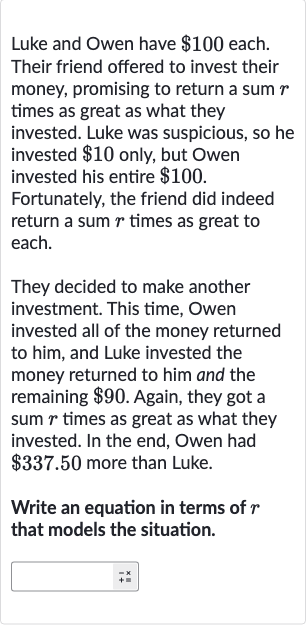AI tutor
Welcome to Bytelearn!
Let’s check out your problem:

Luke and Owen have each. Their friend offered to invest their money, promising to return a sum times as great as what they invested. Luke was suspicious, so he invested only, but Owen invested his entire . Fortunately, the friend did indeed return a sum times as great to each.They decided to make another investment. This time, Owen invested all of the money returned to him, and Luke invested the money returned to him and the remaining . Again, they got a sum times as great as what they invested. In the end, Owen had more than Luke.Write an equation in terms of that models the situation.
Full solution
Q. Luke and Owen have each. Their friend offered to invest their money, promising to return a sum times as great as what they invested. Luke was suspicious, so he invested only, but Owen invested his entire . Fortunately, the friend did indeed return a sum times as great to each.They decided to make another investment. This time, Owen invested all of the money returned to him, and Luke invested the money returned to him and the remaining . Again, they got a sum times as great as what they invested. In the end, Owen had more than Luke.Write an equation in terms of that models the situation.
- Initial amounts of money: Let's denote the initial amount of money both Luke and Owen have as and respectively. We know that . Luke invests \$\(10\)\( and gets back \$10r\), while Owen invests \$\(100\)\( and gets back \$100r\) after the first round of investment.
- First round of investment: After the first investment, Luke has \(\$10r\) from the investment and \(\$90\) that he did not invest, so he has a total of \(\$10r + \$90\). Owen has \(\$100r\) from his investment.
- Total amount after first investment: In the second round of investment, Luke invests the \(\$10r\) he got from the first investment plus the \(\$90\) he didn't invest, so he invests a total of \(\$10r + \$90\). Owen invests the entire \(\$100r\) he got from the first investment.
- Second round of investment: After the second investment, Luke has \(\$(10r + 90)r\) from the investment, and Owen has \(\$(100r)r\) from his investment.
- Total amount after second investment: We are given that Owen has \(\$337.50\) more than Luke after the second investment. So, the equation that models the situation is:\(\newline\)\[(100r)r = (10r + 90)r + 337.50\]
- Equation modeling the situation: To simplify the equation, we distribute the \(r\) on both sides: \(100r^2 = 10r^2 + 90r + 337.50\)
- Simplifying the equation: Now, we subtract \(10r^2 + 90r\) from both sides to get the equation in terms of \(r\):\(\newline\)\[100r^2 - 10r^2 - 90r = 337.50\]
- Combining like terms: Simplify the equation further by combining like terms: \(90r^2 - 90r = 337.50\)
- Final equation in terms of : We can divide the entire equation by to simplify it:\(\newline\)
- Final equation in terms of r: We can divide the entire equation by \(90\) to simplify it:\(\newline\)\[r^2 - r = 3.75\]This is the final equation in terms of r that models the situation. We can write it as:\(\newline\)\[r^2 - r - 3.75 = 0\]
More problems from Solve a system of equations using substitution: word problems
QuestionGet tutor help
QuestionGet tutor help
QuestionGet tutor help
QuestionGet tutor help
QuestionGet tutor help
QuestionGet tutor help
